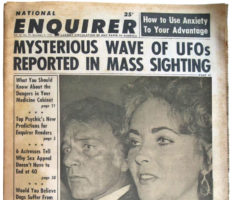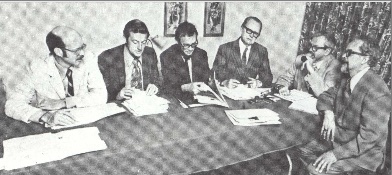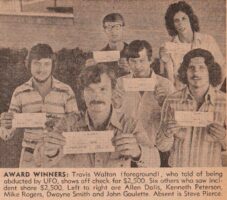by Charles Lear, author of “The Flying Saucer Investigators.”
 Many readers may not be aware that, at one point in time, the National Enquirer was associated with serious UFO research in spite of its reputation as a sensationalistic supermarket tabloid. In 1972, the Enquirer put together what they called “The National Enquirer Blue Ribbon UFO Panel,” which was made up of five UFO researchers, all of whom held PhDs. The Enquirer was offering a $50,000 reward for proof, by the end of the year, that UFOs came from space and were not a natural phenomenon. The panel was tasked with evaluating UFO cases to determine if any of them provided such proof. The panel members included four consultants for the Aerial Phenomena Research Organization, and Dr. J. Allen Hynek, a scientific consultant for the Air Force’s UFO investigation for most of its existence. All of them had good reputations within the UFO community, and the reader may wonder why they would put those at risk by being associated with the Enquirer in such an endeavor. It’s likely that the prospect of getting some of their research funded by the Enquirer may have helped them to put aside any aversions, and the assignment in 1975 of Bob Pratt to the Enquirer UFO desk, who became respected as an investigator in his own right, may have encouraged them to continue their association.
Many readers may not be aware that, at one point in time, the National Enquirer was associated with serious UFO research in spite of its reputation as a sensationalistic supermarket tabloid. In 1972, the Enquirer put together what they called “The National Enquirer Blue Ribbon UFO Panel,” which was made up of five UFO researchers, all of whom held PhDs. The Enquirer was offering a $50,000 reward for proof, by the end of the year, that UFOs came from space and were not a natural phenomenon. The panel was tasked with evaluating UFO cases to determine if any of them provided such proof. The panel members included four consultants for the Aerial Phenomena Research Organization, and Dr. J. Allen Hynek, a scientific consultant for the Air Force’s UFO investigation for most of its existence. All of them had good reputations within the UFO community, and the reader may wonder why they would put those at risk by being associated with the Enquirer in such an endeavor. It’s likely that the prospect of getting some of their research funded by the Enquirer may have helped them to put aside any aversions, and the assignment in 1975 of Bob Pratt to the Enquirer UFO desk, who became respected as an investigator in his own right, may have encouraged them to continue their association.
The January 1972 issue of the A.P.R.O. Bulletin has a front page article headlined “‘Enquirer’ Offers $50,000 Reward.” According to the article, William Dick, in the March 12, issue of the Enquirer announced that they were offering $50,000 to anyone who could offer proof that “an Unidentified Flying Object came from outer space and is not a natural phenomenon.” Dick had attended the APRO Symposium at the University of Arizona and had “talked extensively with Mr. Lorenzen and the Consultants who participated in the symposium.” This resulted in APRO acting as a consulting organization in “this project” and ready to deploy field investigators if need be. Four APRO consultants were chosen to do “the final judging.”
The people making up the panel, along with Hynek, were APRO Consultants Dr. Robert Creegan, Dr. James A. Harder, Dr. Frank B. Salisbury, and Dr. R. Leo Sprinkle. Members and subscribers were encouraged to send in any good leads.
 The March-April 1972 issue of the Bulletin has an article on page 6, headlined “Enquirer Reward Panel,” with a picture showing all of the panel members sitting at a table. It is reported that the panel had recently met in Palm Beach, Florida (the Enquirer had offices in Lantana, Florida), to review the first group of “applications for the $50,000 ‘UFO Proof’ award.” At this meeting, the panel recommended an additional $5,000 award for “best evidence short of conclusive proof,” and this was agreed to at the Enquirer.
The March-April 1972 issue of the Bulletin has an article on page 6, headlined “Enquirer Reward Panel,” with a picture showing all of the panel members sitting at a table. It is reported that the panel had recently met in Palm Beach, Florida (the Enquirer had offices in Lantana, Florida), to review the first group of “applications for the $50,000 ‘UFO Proof’ award.” At this meeting, the panel recommended an additional $5,000 award for “best evidence short of conclusive proof,” and this was agreed to at the Enquirer.
The year went by and the $50,000 was left unclaimed. Before the year was out, however, a collaboration between APRO and the National Investigations Committee on Aerial Phenomena was announced on page 5 of the November-December Bulletin. While NICAP was under the direction of Donald Keyhoe, relations between the two groups were not very friendly. With NICAP now under the direction of Stuart Nixon, the possibility of a cooperative relationship had previously been discussed at a meeting in May of that year, as was announced on the front page of the June 1972 issue of NICAP’s UFO Investigator in an article headlined “NICAP and APRO Take Major Step Toward Improved Relations.” In the midst of their improved relationship, Enquirer General Editor Brian Wells was able to get both groups to agree to work together in screening cases for the Enquirer. John Acuff was the head of NICAP at that time.
As “UFO Proof” continued to be elusive, the Enquirer announced in the June 3, 1975 issue that the award was being increased to $100,000. Then, in the June 13, 1976 issue, it was announced that the award was being increased to $1,000,000. It was also announced that there was a “Judicial Review Board” that would make the final decision regarding the payout. This was made up of two people: Tom C. Clark, an associate justice on the U.S. Supreme Court from 1949 to 1967 and U.S. Attorney General from 1945 to 1949; and Francis Bergan, associate judge for the New York Court of Appeals from 1963 to 1972.
The big money was never paid out, but on several occasions, the award for best evidence was. Notable cases include:
1973: The Delphos Ring Incident
1974: The Coyne Incident
1975: The San Antonio International Airport sighting
1976: The Travis Walton Case
1977: The Tehran UFO Incident
1978: The Memphis Triangle
1980: The Val Johnson Case
 The Enquirer’s involvement in the Walton case got messy, and did some damage to the credibility of APRO. In brief, on November 5, 1975, Travis Walton was working in the Apache-Sitgreaves National Forest near Snowflake, Arizona, on a U.S. Forest Service contract with the contract holder, Mike Rogers and five other workers. They were in a truck headed for home after work when they reportedly came upon a UFO. Walton’s co-workers claimed that he got out of the moving truck, ran towards the UFO, and was knocked back by a beam of light. His co-workers fled, thought better of it, and upon returning, saw no sign of him or the UFO. Walton was missing until, shortly after midnight on November 11, he telephoned his sister from a phone booth and was picked up by his brother about 30 minutes later. What made this case significant was that Travis and his brother both passed polygraph tests arranged by APRO on February 7, 1976, and five out of six of Travis’s co-workers passed polygraph tests on November 10, 1975, conducted at the Navajo County Sheriff’s Office while they were under suspicion of murdering Walton.
The Enquirer’s involvement in the Walton case got messy, and did some damage to the credibility of APRO. In brief, on November 5, 1975, Travis Walton was working in the Apache-Sitgreaves National Forest near Snowflake, Arizona, on a U.S. Forest Service contract with the contract holder, Mike Rogers and five other workers. They were in a truck headed for home after work when they reportedly came upon a UFO. Walton’s co-workers claimed that he got out of the moving truck, ran towards the UFO, and was knocked back by a beam of light. His co-workers fled, thought better of it, and upon returning, saw no sign of him or the UFO. Walton was missing until, shortly after midnight on November 11, he telephoned his sister from a phone booth and was picked up by his brother about 30 minutes later. What made this case significant was that Travis and his brother both passed polygraph tests arranged by APRO on February 7, 1976, and five out of six of Travis’s co-workers passed polygraph tests on November 10, 1975, conducted at the Navajo County Sheriff’s Office while they were under suspicion of murdering Walton.
Arch-skeptic Philip Klass looked into the case and found out that APRO had arranged for a polygraph test for Travis on November 15, 1975, that was paid for by the Enquirer. According to Klass, Travis failed the test, and it was covered up by both APRO and the Enquirer. Klass gave this information, along with evidence to support it, to NICAP. NICAP reports on Klass’s findings in a lengthy front-page article headlined “Walton Abduction Cover-Up Revealed” in the June 1976 Investigator. According to the article, Klass had physical proof “which has been checked by NICAP” in the form of:
1: The polygraph examination statement of consent dated November 15, 1975, and signed by Travis Walton.
2: The examiner’s report to the National Enquirer dated November 16, 1975, which includes his conclusion that the UFO account was a hoax
3: The voucher receipt from the National Enquirer payable to the examiner’s Arizona Polygraph Laboratory dated January 14, 1976.
4: The agreement to conduct the test and supply a report to the National Enquirer.
According to the article, the examiner was instructed by the Enquirer to keep quiet about the test. It is added that APRO failed to mention the test in the account of Walton’s case that was published in the November 1975 Bulletin.
The Blue Ribbon Panel continued throughout the 70’s and came to include members of the Mutual UFO Network, a group that had split off from APRO amidst a good deal of animosity. After the panel faded away in the 1980s, its place in UFO history seems to have also. According to Isaac Koi, who wrote an extensive blog on the panel, the panel is “rarely mentioned in modern discussions of UFOlogy.” He offers two reasons:
Most ufologists are either:
- unaware of the work done by National Enquirer’s Blue Ribbon Panel and those associated with it (including the considerable collaborative work by APRO, NICAP, MUFON and several leading ufologists); or
- would prefer not to mention the National Enquirer, due to its image.
This blog was inspired by Curt Collins’s September 2019 treatment of the subject posted on The Saucers That Time Forgot.